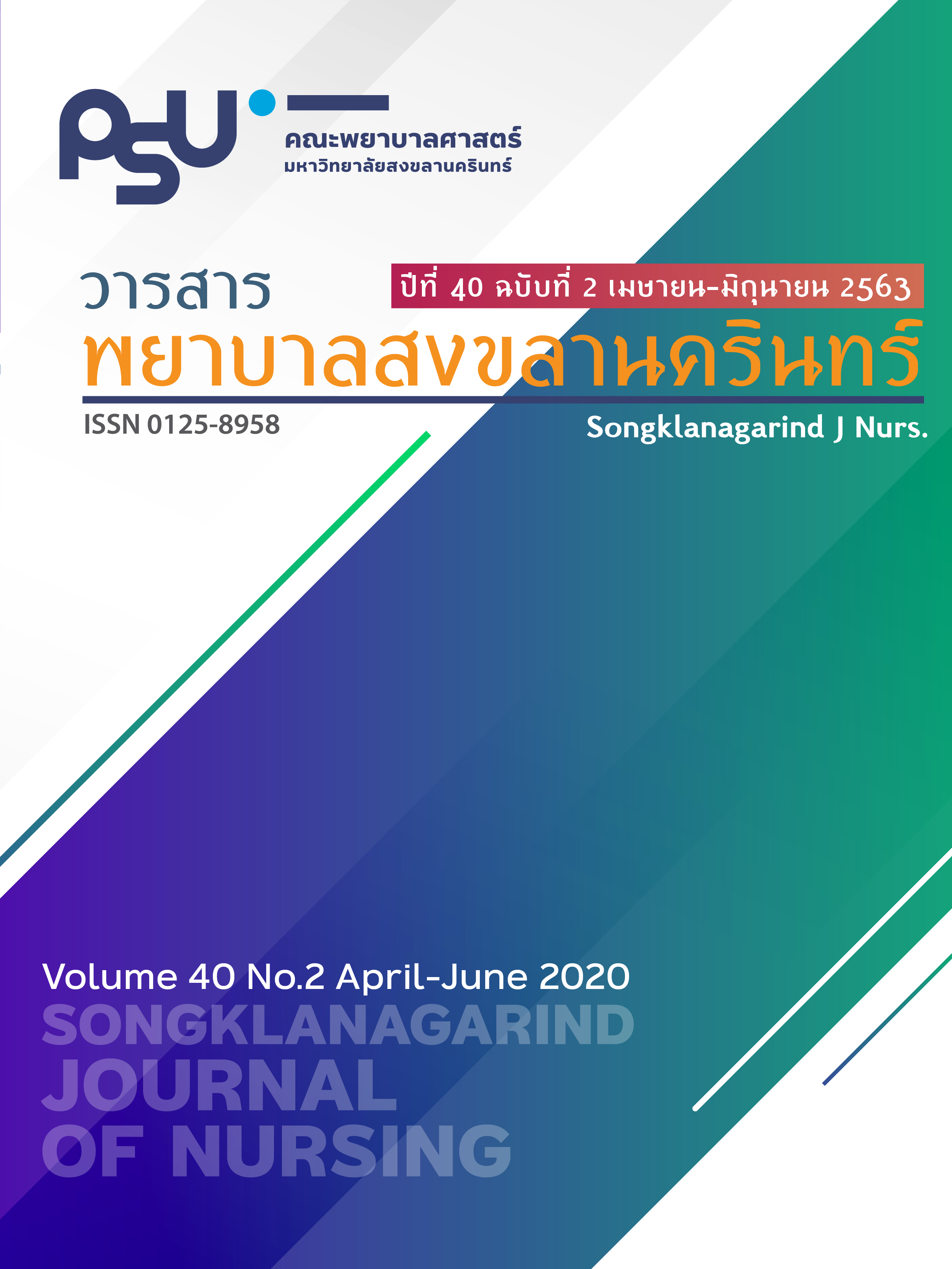Development and Evaluation of Care Quality Indicators for Nursing Homes in China
Main Article Content
บทคัดย่อ
This study aimed to develop a valid and reliable indicator for evaluating care quality provided to the assisted living Chinese elderly in nursing homes. The development phase included concept development, literature review and a qualitative approach using semi-structured interviews with 20 participants. The evaluation phase consisted of two steps, pretesting and final testing of its measurement properties, including content validity evaluation, inter-rater reliability assessment, and hypothesis testing.
The results revealed three domains within the conceptual structure of nursing home care quality (NHCQ): culturally sensitive care, safe care environment, and self-care management, that covered four care aspects on activity and rest, nutrition and hydration, psychosocial health and wellness, special care and end of life care. The components of the NHCQI-China, I stands for Indicator, were classified by frequency of care action: on admission and regular basis. The items of NHCQI-China comprised: assessment, implementation, and evaluation with two choices as its criteria. The NHCQI-China obtained a Content Validity Index (CVI) of 0.93, the total percentage agreement of 89% verified reliability by inter-rater approach. The construct validity evaluation of the indicator, which used hypothesis testing on the differences in satisfaction scores rated by the elderly and displayed high and low care quality scores, was found to be significant (t = 5.737, p < 0.05). In conclusion, The newly developed NHCQI-China is able to provide a minimum data set of care quality for nursing homes and can be used to further develop care practice guidelines or care standards. This a tool might be beneficial for managing the care quality of nursing homes in China in the future.
Article Details
เอกสารอ้างอิง
National Bureau of Statistics of China. Statistical communiqu of the people’s republic of china on the 2013 national economic and social development [Internet]; 2014 [cited 2014 Feb 24]. Available from: http://www.stats.gov. cn/tjsj/zxfb/201402/t20140224_5147970.html.
Jiang QB, Sanchexz-Barricarte. The 4-2-1 family structure in China: a survival analysis based on life tables. Eur J Ageing. 2011; 8(2): 119-27. doi: 10.1007/s10433-011-0189-1
Li M. Pension institution situation and investi gation. J. Working Guide. 2016; 1: 43- 47.
MuGZ. Dilemma and countermeasures of China’s pension institution development. J. Humanities and Social Sciences in Huazhong Normal University. 2012; 51(2): 31-8.
Shi CH, Ren XH, Zhang YH, et al. Research progress on nursing risk management in pension institution. J China PLA. 2016; 33: 43-46.
Li J. Quality of service and influence factors of Nanjing city pension agency. J. China Gerontology. 2013; 33: 4820-22.
Shi Y, Yang HH, Tang YF, et al. Research on risk factor of elder fall in pension institution. Nursing J China PLA. 2015; 32(12): 35-38.
Wang QY, Song LJ. Impact factor of quality of life in chronic disease elder. J. China Gerontics. 2013; 9(33): 4614- 15.
Zhu H, Walker A. Pension system reform in China: Who gets what pensions?. Social Policy & Administration. 2018; 52(7): 1410- 24. doi : https://doi.org/10.1111/spol.12368
Shanghai municipal people’s congress standing committee announcement [Internet]; 2014 [cited 2014 Aug 7]. Available from: http://www. spcsc.sh.cn/shrdgzw/node4/node22/node36/ n116/u1ai57979.html
Morris JN, Murphy K, Nonemaker S. Long term care facility resident assessment instrument (RAI) 3.0: User’s Manual. Health Care Financing Administration: Baltimore, MD. 2018.
Hutchinson AM, Milke DL, Maisey S. et al. The Resident Assessment Instrument-Minimum Data Set 2.0 quality indicators: a systematic review. BMC Health Serv Res. 2010; 10-166 .
Wan TTH, Breen GM, Zhang NJ, et al. Improving the Quality of Care in Nursing Homes: An Evidence-Based Approach. Baltimore: Johns Hopkins University Press; 2010.
Rantz MJ, Aud MA, Zwygart-Stauffacher M, et al. Field testing, refinement, and psychometric evaluation of a new measure of quality of care for assisted living. J. Nurs Measurement. 2008; 16(1): 16-30. doi: 10.1891/ 1061-3749.16.1.16
Guo HY, Wang L, Peng JL, et al. Development of service quality indicators for long-term care facilities. Chinese Journal of Nursing. 2014; 49(4): 394-98.
Orem DE, Taylor SG. Reflections on nursing practice science: the nature, the structure, and the foundation of nursing sciences. Nurs Sci Q. 2011; 24(1): 35-41. doi: 10.1177/089 4318410389061.
Leininger MM, McFarland MR. Culture Care Diversity and Universality: A Worldwide Nursing Theory. 2 nd ed. Jones & Bartlett: Sudbury MA; 2006.
Mauk KL. Gerontological nursing competencies for care. 4 th ed. Jones and Bartlett: Sudbury MA; 2018.
Miller CA. Nursing for wellness in older adults: Theory and practice. 8 th ed. Philadelphia: Lippincott Williams & Wilkins; 2019.
Craven RF, Hirnle CJ. Henshaw C. Fundamentals of Nursing. Human Health and Function. 8 th ed. Philadelphia: Wolters Kluwer Lippincott Williams & Wilkins; 2009.
Donabedian A. Evaluating the quality of Medical Care. The Milbank Quarterly: A Multidisciplinary. J Population Health and Health Policy. 2005; 83(4): 691-729. doi: 10.1111/ j.1468-0009.2005.00397.x
Schwartz-Barcott D, Kim HS. An expansion and elaboration of the hybrid model of concept development. In Concept Development in Nursing: Foundations, Techniques and Applications, 2 nd ed. In: Rodgers, BL. & Knafl KA. eds, W.B. Saunders, Philadelphia, PA; 2000. 129-159.
Waltz CF, Stricklan OL, Lenz ER. Measurement in nursing and health research. New York: Springer; 2017.
Polit DF, Beck CT. Nursing research: generating and assessing evidence for nursing practice. 10 th ed. Lippincott Williams & Wilkins; 2017.
Maneesrisongul W, Dixon JK. Instrument translation process: a method review. J Adv Nurs. 2004; 48(2): 175-86. doi: 10.1111/j.1365- 2648.2004.03185.x.
Yang F, Bao JM, Huang XH, et al. Measurement of resilience in Chinese older people. J International Nursing Review. 2015; 62(1): 130-39. doi: 10.1111/inr.12168.


